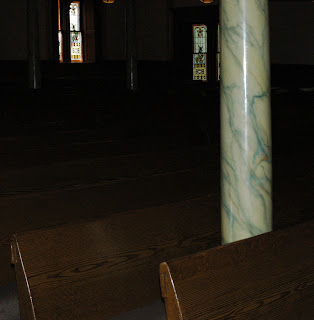Temple Town
Salt Lake City is truly a temple town. It was, after all, founded by Mormon pioneers in 1847 under the leadership of their prophet, Brigham Young. The headquarters of The Church of Jesus Christ of Latter-day Saints is still located in Salt Lake City.
In Salt Lake City, even the roads are named in relationship to the temple. In the centre of town is the walled, ten acre Temple Square complex that contains Salt Lake Temple, Salt Lake Tabernacle, Salt Lake Assembly Hall, the Seagull Monument and two visitors' centers. In either of the two visitors' centres you can see displays of religious art and "historical" displays, as well as information about the modern day good works of the church. You can also climb aboard a guided tour led by two missionaries who have been posted here from somewhere in the world. The tour is approximately equal parts history and propaganda, but is well worth doing just for the experience.
The Salt Lake Temple was begun in 1853, that's just six years after they arrived and before all the pioneers had proper housing. The temple was dedicated in 1893. This is the great Mormon landmark that is instantly recognisable to church members all over the world. Elder Weinberger once told me that to enter this temple brings great blessings, eagerly sought by the faithful.
The Tabernacle is the home of the Mormon Tabernacle Choir and the Orchestra at Temple Square. Normally visitors are allowed inside to look around and listen to the choir rehearse, but on the day I visited it was closed for recording. My missionary guides informed me that the building's distinctive, acoustically beneficial, oval shape was given in a vision from God to the prophet Brigham Young. I consider it possible that an educated man like Brigham Young may have had a brush with the ancient science of acoustic architecture, but this didn't seem like the right moment to debate the idea.
The Salt Lake Assembly Hall looks from the outside like a Victorian Gothic cathedral. On the inside it is much more plain, without vaulted ceilings or Gothic style ornamentation. What little bling there is in the hall is fake. The "marble" and furnishings are actually plain local timber, painstakingly hand-painted to resemble more valuable and desirable materials.
The so-called Beehive House was the residence of Brigham Young. The beehive concept represents industry, a strong theme in the Mormon Church and in Young's personal philosophy. There is even a Beehive sculpture on the roof of the house. It was constructed of adobe and sandstone in 1854 and is now a restored house-museum filled with Brigham Young artifacts. Two years later the adjacent Lion House was constructed to house Young's enormous family. A man with 51 wives is going to need a lot of space. The Lion House was constructed to house just 12 of these wives and their children and became Young's primary residence. It is now a tea room.
The only mention of Brigham Young's extraordinary polygamy was made in the negative, when the missionary guide explained as we climbed the stairs that polygamy is no longer sanctioned by the Mormon Church. Only one wife was mentioned on the tour and she was presented as the mistress of the Beehive House. No mention was made of the purpose of the Lion House, except that it was to provide more accommodation for the large family (12 more wives and their children).
I also met an Aussie at the Beehive House. She is a missionary posted to Salt Lake City. This was notable only for the thrill I felt at having someone ask me how I was "going" instead of how I was "doing."
Despite the burdens of his church and public offices, and his enormous family, Brigham Young still found time to exercise his many talents. Industry really was important to him. He was, among other things, a skilled carpenter who built the clock-barometer still displayed in the Beehive House.
The modern needs of the church are also visible in this area, including the giant Conference Centre now used for its massive events.
Everyone I met in Temple Square was working for the church. They were perfectly friendly and pleasant at all times. They were welcoming, warm and tremendously helpful. I was terrified of every single one of them. It was an interesting sensation. It seems that all my rationality is not enough to protect me from the superstitious dread of contamination by proximity to irrationality. The proposition is an illogical and unshakable manifestation of exactly the kind of magical thinking that makes me so nervous in devoutly religious people. Perhaps I had good reason to fear after all.

No comments:
Post a Comment